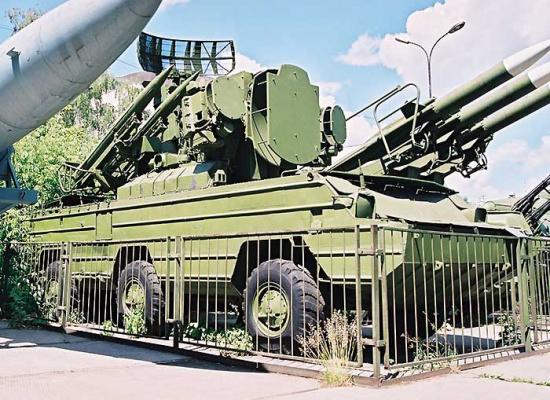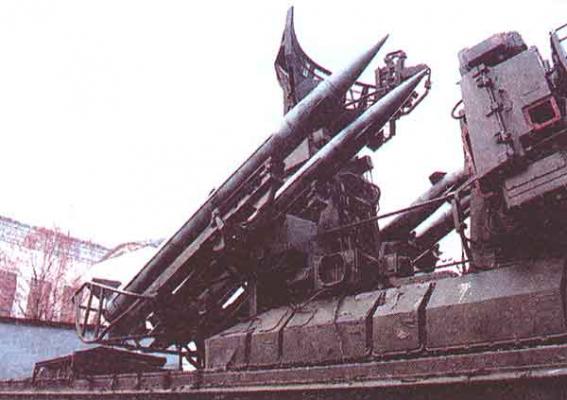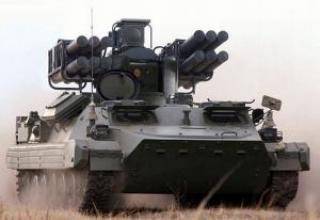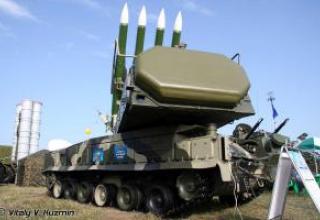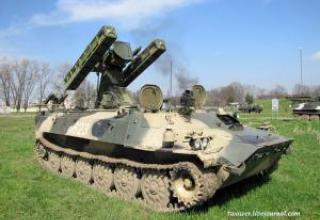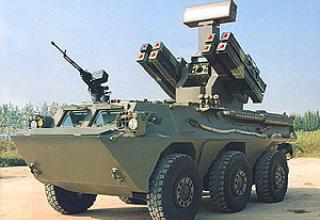The development of an autonomous self-propelled military antiaircraft missile system "Wasp" (9K33) began in accordance with the Decree of the USSR CM dated October 27, 1960. For the first time, the task was to develop an autonomous complex with placement on one self-propelled floating chassis (combat vehicle) as all combat vehicles, including radar stations and launcher with missiles, as well as communications, navigation and surveying, control, and power supply sources. New were the requirements to detect air targets in motion and to engage them by fire from short stops. The weight of SAMs was limited to 60-65 kg, which would allow two soldiers to manually charge the launcher.
The main purpose of the complex was to cover the forces and means of motorized infantry divisions from low-flying targets. At the same time, the Decree tasked the development of the Osa-M ship's SAM system using a missile and a part of the Osa complex's electronic means.
The head designer of the overall SAM system and the 9AZZ combat vehicle of the 9KZZ complex was determined by the Research Institute-20 of the State Committee for Environmental Protection. M.M.Kosichkin was appointed as the Chief Designer of the complex and the vehicle. The Design Bureau of Plant No.82 of the Moscow City Council of the People's Commissariat for Defense headed by A.V.Potopalov was charged with the missile development.
The development of the concept of the Wasp SAM system was influenced by the information on the work carried out in the USA on the development of the autonomous self-propelled SAM system "Mauler" with the placement of all its facilities on the chassis of the M-113 tracked multi-purpose armoured personnel carrier (APC) widely introduced in those years. It should be noted that, ultimately, the Americans failed to create this complex.
The development of the Wasp complex was also very difficult in the USSR. Repeatedly, the time frame for development of the missile components, chassis and the entire complex was interrupted. As a result, by 1962 the works actually never left the stage of experimental laboratory testing of the main systems. This failure was predetermined by excessive optimism in evaluating the prospects for the development of domestic solid fuels and the element base of on-board equipment of the control system. At the stage of development of tactical and technical requirements the complex was called "Ellipsoid".
By the Decree of the CPSU Central Committee and the USSR CM dated September 7, 1964, Plant No. 82 (Tushino Machine-Building Plant) was exempted from the work on missile 9MZZ with the connection instead of it OKB-2 GKAT led by Grushin, and a new start date for testing - II quarter 1965. The permissible starting mass was doubled and brought up to the realistically achievable level - 110-115 kg. It was intended to defeat targets with MIG-19 ESR flying at 500 m/s at a range of 8-10 km at flight altitudes from 50-100 m to 5 km, and the same targets at subsonic speeds - at ranges up to 10-13 km and altitudes up to 6-7 km.
The Decree of the USSR Council of Ministers also set a new deadline for submission of SAMs for joint testing - II quarter of 1970. V.P. Efremov, Director of NIIEMI MRP (former NII-20 SCRE) was appointed Chief Designer of "Osa", I.M. Drize was appointed Deputy Chief Designer. By decision of the Commission of the Presidium of the USSR Council of Ministers on Military and Industrial Issues, the development of the floating hull wheel chassis 937 (later - 5937 or "Osnova") for the "Wasp" SAM was assigned to the Bryansk Automobile Plant of the Ministry of Aircraft Industry.
In March-June 1970, the factory tests of SAMs were successfully completed at the Emba test site, and from July 1970 to February 1971 - joint tests under the leadership of the State Commission headed by M.M.Saveliev. The complex was adopted by the Decree of the CPSU Central Committee and the USSR CM on October 4, 1971. At the same time, the Osa-M SAM system entered service with the Navy ships.
At present, production of the complex is completed. Wasp 9K33 SAMs were delivered to Angola, Algeria, Greece, India, Iraq, Jordan, Libya, Poland, Syria and Yugoslavia. The complex is in the service of 19 countries.
In the west, the complex was designated SA-8 "Gecko".
Composition:
Wasp" 9K33 SAM consisted of:
- A 9A33B reconnaissance, pointing and launch vehicle with four 9M33 anti-aircraft guided missiles,
- 9T217B transport and charging machine with eight ZUR,
- control and maintenance equipment mounted on vehicles.
The 9A33B combat vehicle was located on a three-axle chassis BAZ-5937, equipped with a water cannon to move afloat, with a powerful undercarriage diesel engine, means of navigation, top linking, life support, communications and power supply of the complex (from the gas turbine unit and from the generator of power take-off of the running engine). The air transportability of the IL-76 airplane and transportation by railway within the limits of the size 02-T were provided.
The target detection radar placed on the 9A33B combat vehicle behind the transport and launch containers was a coherent-pulse radar with a circular view of the centimetre range with an antenna stabilized in the horizontal plane, which made it possible to search and detect targets while the complex was moving. The radar carried out a circular search by rotating the antenna at a speed of 33 rpm, and on the corner of the place - prerebroskoy beam in one of three positions at each antenna rotation. With pulsed radiation power of 250 kW, the sensitivity of the receiver is about 10E-13 W, width of the beam on azimuth 1°, on the angle of the place - from 4° in the two lower positions of the beam and up to 19° in the upper position (the total sector of view at the corner of the place was 27°), the station detected the fighter at a range of 40 km at a flight height of 5000 m (27 km - 50 m). The station was well protected from active and passive interference.
Installed on a combat vehicle tracking radar centimeter range of waves at a pulse power of 200 kW, the sensitivity of the receiver 2x10E-13 W and a beam width of 1 ° provided target acquisition by car escort at a range of 23 km at a flight height of 5000 mi 14 km at a flight height of 50 m. The station was well protected from active and passive interference. The standard deviation of the target tracking was 0.3 d.e.. The standard deviation of the target tracking was 0.3 d.e. (i.e. 0.06°) by angular coordinates and 3 m by distance. The station had a system of selection of moving targets and various means of protection against active interference. At strong active hindrances can be accompanied by a television optical visier and radar detection.
In the radio command guidance system of the Wasp complex two sets of wide and medium beams antennas were used to capture and enter into the beam of the target tracking station of the two ZUR at launch with a minimum interval (3-5 s). When firing at low-flying targets (at altitudes of 50-100 m), a "slide" method was used to ensure that the SAM system approached the target from above, which made it possible to reduce errors in launching the missile at the target by eliminating the triggering of the radio detonator from the ground.
Surface-to-air missile 9M33 is based on the "duck" scheme. The missile does not stabilize on the heel, and therefore, the on-board equipment provides a command layout. To reduce the slope created by the impact on the wings of the air flow disturbed by the rudders, the wing unit was made by freely rotating on a bearing relative to the longitudinal axis of the missile, the main units of the missile - radio control equipment (command radio block) and radiovizirovaniya (literal transponder), autopilot, radio detonator, on-board power supply, combat unit with a safety executive mechanism - were located in the bow of the ZUR. In the tail part of the missile were located the engine, antennas of the command radio unit and the on-board transponder, as well as routes to accompany the missile with the help of a television optical vizier. The LLRS did not require any prelaunch preparation, except for the installation of onboard radio equipment while the PU was being charged.
The missile was delivered to the troops in a combat-ready form and did not require any remedial or verification work during operation (except for routine inspections once a year).
The complex provided target engagement at 300 m/sec at 200-5000 m altitudes in the range from 2.2-3.6 to 8.5-9 km (with maximum range reduced to 4-6 km for targets at low altitudes - 50-100 m). For supersonic targets flying at a speed of up to 420 m/s the far limit of the kill zone did not exceed 7.1 km at 200-5000 m altitudes. The parameter was from 2 to 4 km. The probability of hitting an F-4C ("Phantom-2") target with a single missile was 0.35-0.4 at an altitude of 50 m and increased to 0.42-0.85 at altitudes above 100 m, based on the results of simulations and combat launches of SAMs.
The self-propelled chassis provided the average speed of the complex on unpaved roads during the daytime - 36 km/h, at night - 25 km/h with the maximum speed on the highway up to 80 km/h. When afloat, the speed reached 7 ... 10 km/h.
The serial production of Wasp SAMs was organized: - Fighting vehicle 9A33B - at the Izhevsk electromechanical plant MRP, - ZUR 9M33 - at the Kirov Machine-Building Plant named after XX of the MAP Party Congress.
Characteristics:
| Rocket | 9М33 |
| Mass of the rocket, kg | 128 |
| Weight of combat unit, kg | 15 |
| The length of the rocket, mm | 3158 |
| Case diameter,mm | 206 |
| Wingspan, mm. | 650 |
| ZUR flight speed, m/sec | 500 |
| Defeat zone, km | |
| - at a distance | 2..9 |
| - in height | 0,05..5 |
| - as defined in | 2-6 |
| Probability of hitting a single ZUR fighter. | 0,35..0,85 |
| Maximum speed of targets to be hit, m/s | up to 420 |
| Response time, s | 26-34 |
| Deployment time, mines | 3-5 |
| The number of SSDs on a combat vehicle | 4 |
| Year of adoption | 1972 |
Testing:
In Wasp" SAMs with relatively short range it was possible to provide a high energy ratio of signals reflected from the target to interference, which made it possible to use radar channels for target detection and tracking even in conditions of intensive interference, and in case of their suppression - TV-optical vizier. In terms of interference immunity, the Wasp SAM system outperformed all first-generation military anti-aircraft systems. Therefore, when using the Osa SAM system in combat operations in southern Lebanon in the early eighties, the enemy, along with means of electronic countermeasures widely used a variety of tactical techniques aimed at reducing the combat capabilities of the complex, in particular, the mass launch of drones simulating combat aircraft with a subsequent attack of attack aircraft on the positions of the spent SAM system,
The complex was also used by Libya on April 15, 1986 against American bombers, but according to foreign press reports, not a single target was shot down.
During the hostilities of 1987-88 in Angola against the South African Air Force, the wasp complex was also used. Two remotely manned aircraft and a visual observation aircraft were shot down.
Prior to the start of Operation Desert Storm, a special unit of the multinational force, using helicopters, infiltrated Kuwaiti territory, captured and removed Wasp Manifesters with all technical documentation, while capturing a combat calculation consisting of Iraqi soldiers. According to press reports, an American cruise missile was shot down by an Iraqi Osa SAM system during the hostilities in early 1991.
Sources:
- Зенитные ракетные комплексы ПВО СВ. Техника и вооружения №5-6.99
- ARMY AIR DEFENCE
- Rest-of-World Missile Systems
- Russian Surface to Air Missiles
